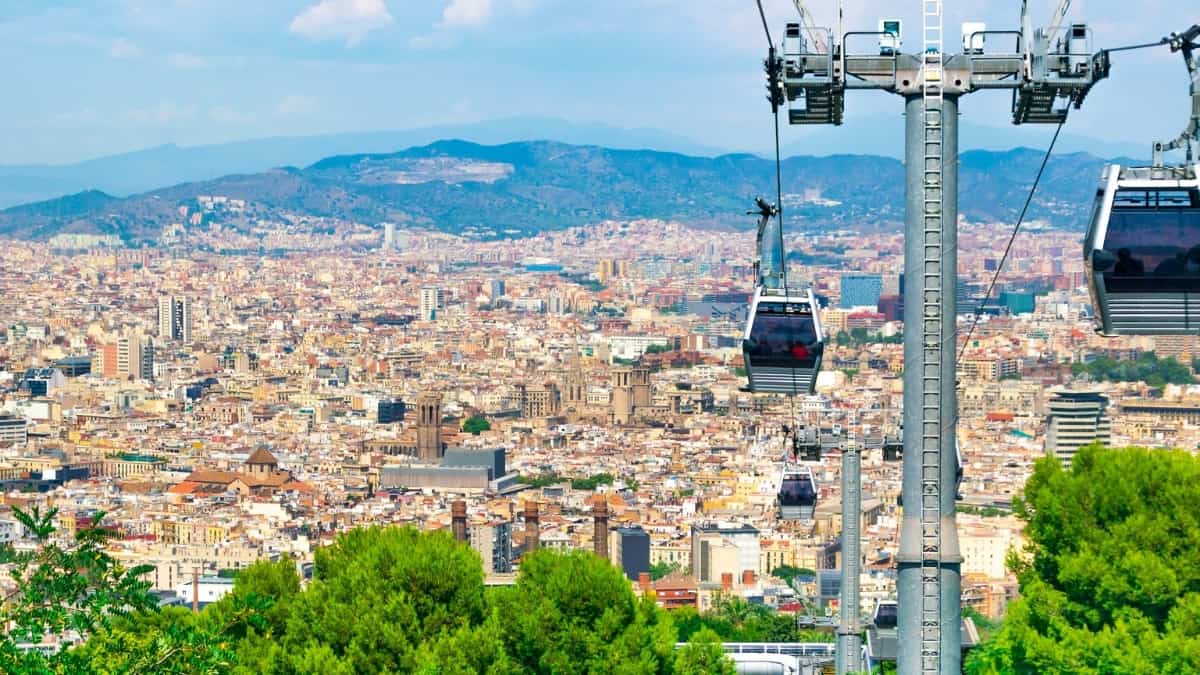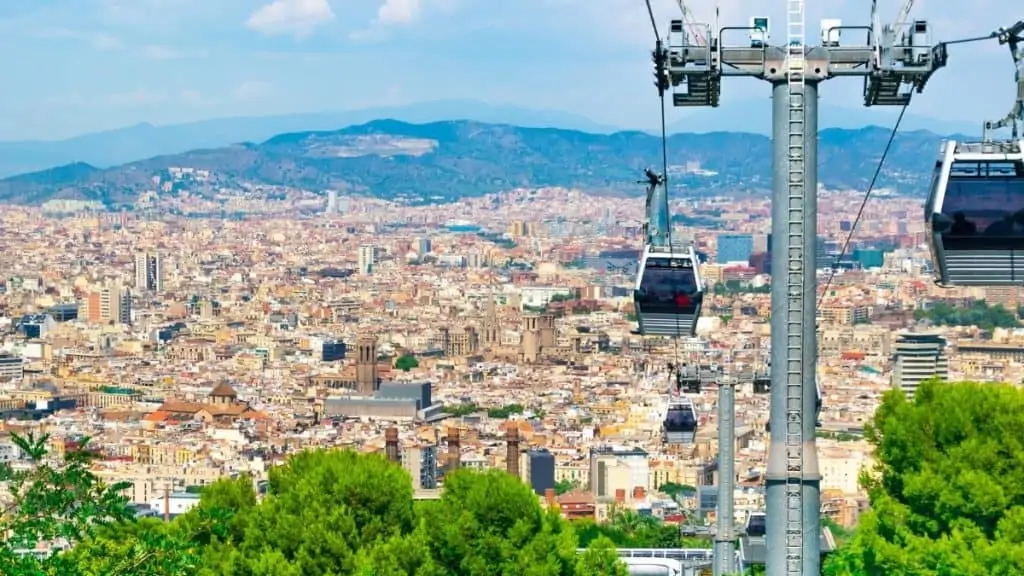
Montjuic cable car is a two-in-one experience: it transports you to the top of Montjuïc Hill and offers fascinating panoramic views of Barcelona on the way up.
The cable car links the funicular station at Paral·lel station to Montjuïc Castle, on top of Montjuïc mountain.
During the 752-meter (2467 feet) run above the ground, you will sit in modern cabins and see Barcelona’s most famous structures and landmarks.
While experiencing the cable car, you can also visit other attractions such as Fundació Joan Miró, the Museu Nacional d’Art de Catalunya, Poble Espanyol, etc.
This article covers everything you must know before buying Montjuic cable car tickets.
Top Tickets
# Montjuic cable car tickets
# Montjuic Castle & Cable Car
# Six-hour guided tourIt’s highly recommended to book your Montjuic cable car tickets in advance. These tickets sell out quickly, so securing your spot early ensures you don’t miss out on this unforgettable experience.
What’s ahead
Things to know before booking tickets
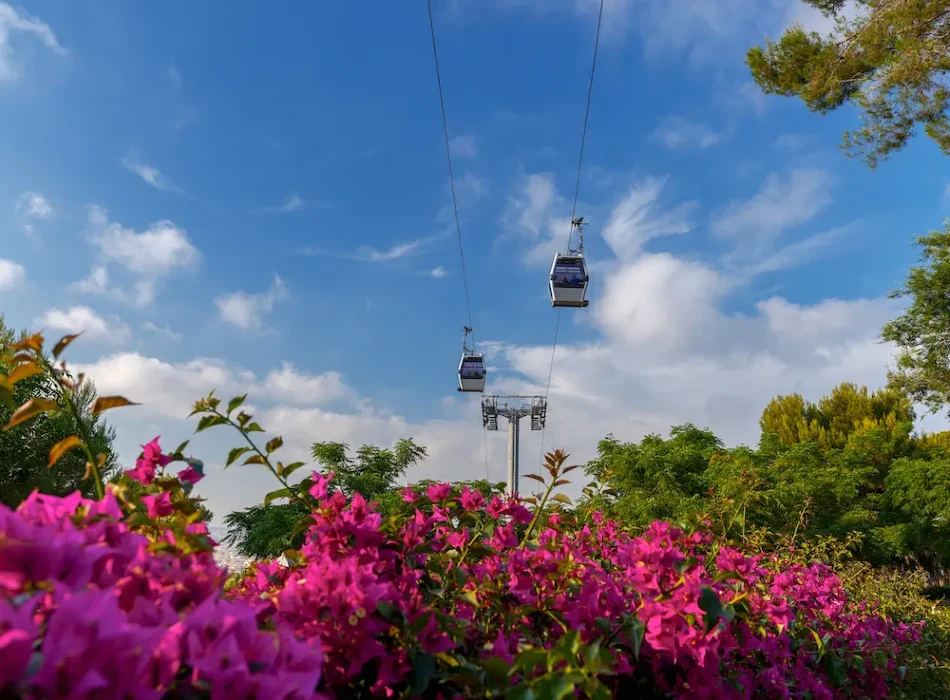
You need to buy tickets to board the Montjuic cable car and reach the top of Montjuïc hill.
It is better to purchase tickets online because you can avoid the queue at the station’s ticket counter.
With these tickets, you can hop on and off at any of three stations: Parc de Montjuïc, Miramar, and Castell de Montjuïc.
You can either purchase return tickets (available online) or one-way tickets.
One-way tickets are available only at the ticket counters at the stations.
Even though there are other ways of getting to Montjuïc Hill, tourists and most locals opt for the cable car tickets because it offers a bird’s-eye view of Barcelona.
Montjuic Castle & Cable Car
If you aren’t on a budget holiday, we highly recommend this 3.5-hour guided tour, including the cable car experience and a visit to Montjuic Castle.
You start the walking tour in the city center, visit the Old Town and the famous Boqueria Market, and numerous attractions on the way before taking the cable car to the hilltop.
After exploring the castle, you visit the building’s dungeons.
The final stop is the castle’s terrace for the city’s most spectacular, panoramic viewpoints.
You can get down whenever you want with your cable car ticket.
Cost of tickets
When you buy Montjuic cable car tickets online, you get a 10% discount as opposed to the tickets at the cable car stations, which are costlier.
The adult ticket costs €14 for visitors aged 13 years and above.
Children between four and 12 years old pay a discounted price of €11.
Infants aged three years and younger can join the ride for free.
Buy This TicketRecommended reading: 12 must-know tips before visiting Montjuic Cable Car
Recommended
Montjuic Cable Car route
Locally known as Telefèric de Montjuïc, the cable car has three stops: Parc Montjuic, Castle, and Mirador.
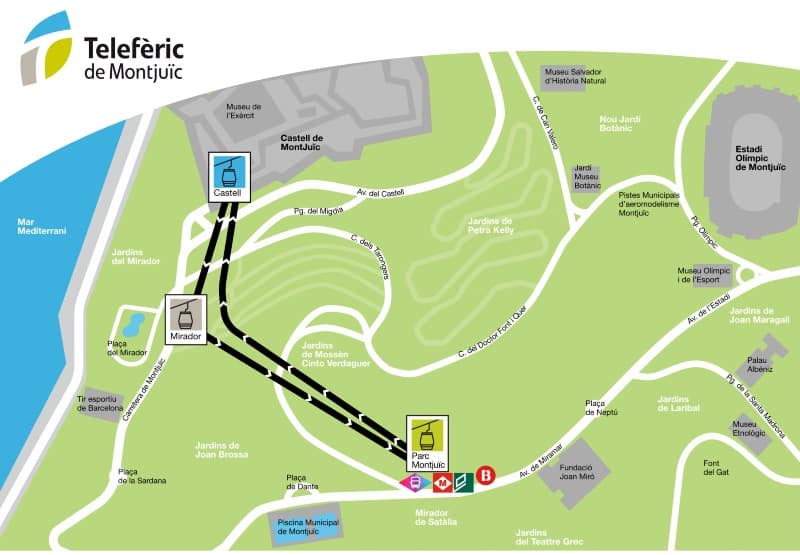
The service starts at Parc de Montjuïc, halfway up Montjuïc mountain on Avinguda de Miramar, and goes directly to the Castle stop. There are no stops in between.
While returning from the Castle, it takes a different route and stops at the Mirador.
You can continue to stay in the cable car and get back to the Parc Montjuic stop, but we recommend you get down and explore.
From Mirador, the car returns to the starting point – the Parc Montjuic stop.
Some visitors get off at the Mirador stop and walk to Parc de Montjuïc.
Where to get down
Depending on what you want to do, you must choose one of these Montjuic cable car stops.
Parc Montjuic
Montjuïc Mountain’s main cultural attractions, such as Fundació Miró, the National Art Museum of Catalonia, Poble Espanyol, and Barcelona Ethnological Museum, are all near this stop.
Olympic Ring, the site of the Barcelona ’92 Olympic Games, is also nearby.
Castle stop
If you want to visit Montjuïc Castle but want to avoid the exhausting climb up, you must get down at the Castle stop.
Besides the Castle, visitors also explore the Montjuïc Mountain Gardens – Botanical Garden, Joan Brossa Gardens, and Mossèn Cinto Verdaguer Gardens.
Mirador stop
Get down at the Mirador stop if you want the best views of Barcelona city.
There are numerous terraces and lookout points, such as Mirador de l’Alcalde, Miramar Gardens, and the Mossèn Costa i Llobera Gardens.
Timings
Montjuic cable car service times vary by month.
However, all throughout the year, the service starts at 10 am.
From November to February, the cable car runs till 6 pm every day.
From March to May and during October, the service hours are up to 7 pm daily.
The serviceable hours for June to September end at 9 pm every day of the week.
On December 25, January 1 and 6, the hours are from 10 am to 2.30 pm.
The last entry is an hour before closing.
What to expect
Montjuic cable car is locally known as Telefèric de Montjuïc.
Check out the video on what to expect during your ride.
What to see at Montjuic Hill
Montjuic Hill has cultural attractions, historic sites, parks, gardens, and even a castle.
Montjuic Castle
Montjuïc Castle is at the summit of Montjuïc Mountain, 173 meters (568 feet) above sea level.
The fortress was built during the Reapers War in 1640 and, over the years, used to defend Barcelona and bombard it.
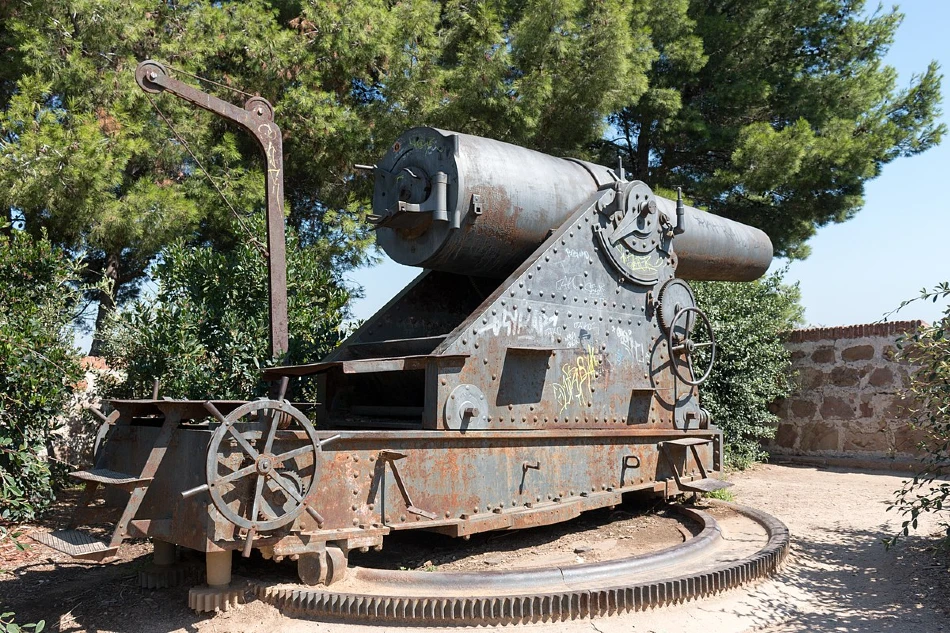
To explore Montjuïc Castle, you must purchase entry tickets at the gate.
Do not miss out on the sculpture at the castle’s moat, which pays tribute to the ‘meter.’
At the Montjuïc Castle in 1792, French geographer and astronomer Pierre-André Méchain defined ‘meter’ as the new unit of measurement.
Sop: Castle
National Art Museum of Catalonia
The National Art Museum of Catalonia houses the world’s best exhibitions of Romanesque art.
You can also see masterpieces of Gothic, Renaissance, Baroque, and modern art during your visit.
Visitors usually spend around two hours exploring the 25,000 exhibits on display.
The art museum opens at 10 am all through the year. It remains open till 8 pm in summer, and during winter, it closes at 6 pm. On Sundays and public holidays, it closes at 3 pm.
Stop: Parc Montjuïc
Magic Fountain of Montjuïc
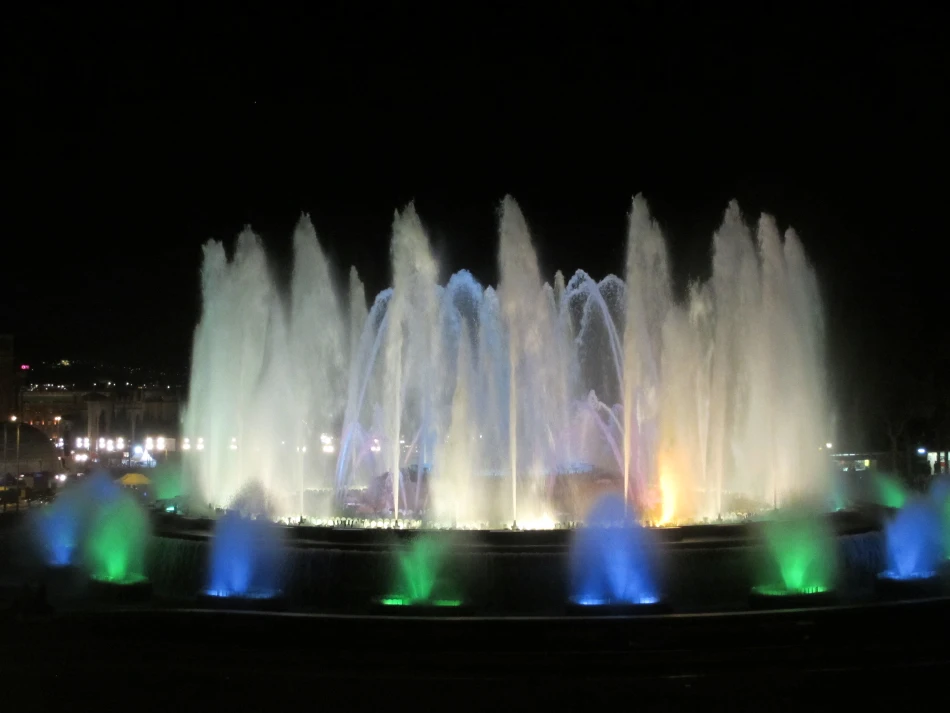
The Magic Fountain, located at the bottom of the mountain, has become a symbol of Barcelona.
It was built for the 1929 Universal Exposition, but even today, locals and tourists gather around daily to enjoy the mesmerizing spectacle of water choreography.
After dark, the Magic Fountain illuminates the Catalan capital. The music starts even as the fountain lights up in different colors and shades, and the water dances to the melody.
Shows last 10 to 15 minutes, and entry is free for all.
This guided tour includes a visit to Barcelona’s Magic Fountain.
Stop: Parc Montjuïc
Archaeology Museum of Catalonia
The Archaeology Museum of Catalonia exhibits archaeological remains illustrating the evolution of Catalonia and its environment from the first prehistoric settlers to the medieval period.
The exhibits originate from Catalonia archaeological sites and others from the Iberian peninsula and Mediterranean locations.
The highlights of the Archaeology Museum of Catalonia include:
- Crown from the 8th-century Treasure of Torredonjimeno
- The jaw of a Neanderthal from 53,200 years ago
- Iberian Treasure of Tivissa, from the 4th to 3rd centuries BC
- Roman statue of Priapus found at Hostafrancs from 2nd century
Stop: Parc Montjuïc
Poble Espanyol
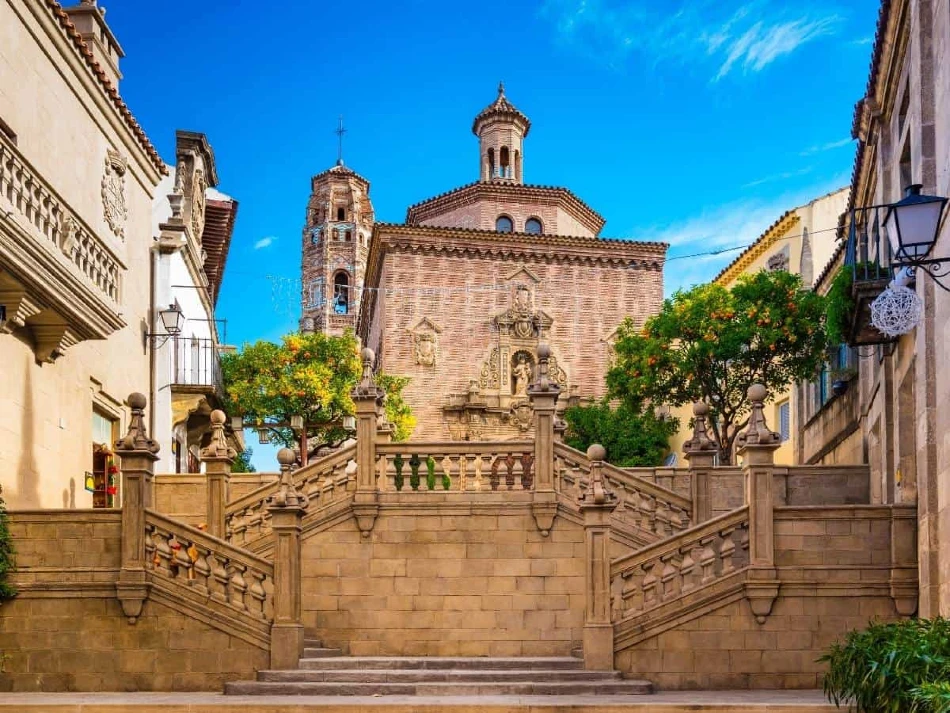
Poble Espanyol is an open-air architectural museum home to replicas of more than a hundred buildings from different parts of Spain.
At this attraction, visitors see a typical Andalusian district and examples of Romanesque architecture, among other features.
Together, they make up a miniature town with streets, houses, squares, theatres, food joints, and craft workshops.
For a better experience, ask for the audio guides at the entrance.
To enter Poble Espanyol, you need to buy tickets, and it is better to get them online.
Stop: Parc Montjuïc
Barcelona Botanical Gardens
Barcelona Botanical Garden’s 14 hectares has more than 1,300 plants from five Mediterranean regions – Australia, California, Chile, South Africa, and the Mediterranean Basin.
The garden aims to protect and promote Mediterranean plants from all around the world.
Stop: Castle Stop
Fundació Joan Miró
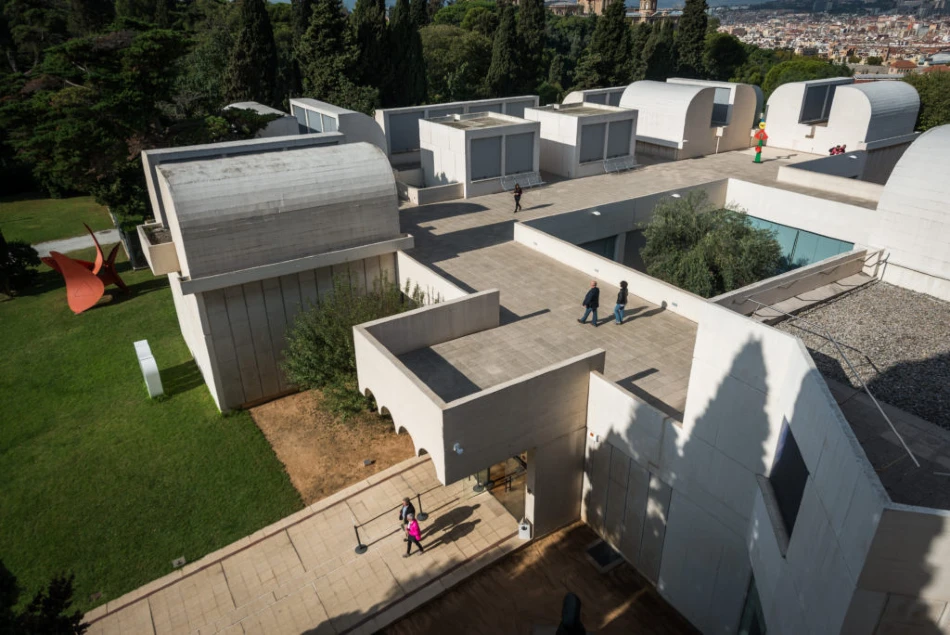
The Fundació Joan Miró building is integrated into the landscape while retaining its own unique charm.
The art museum houses 14,000 pieces by the Catalan artist Joan Miró.
The art foundation has existed for more than 45 years and exhibits Miró’s art and the latest contemporary art.
Stop: Parc Montjuïc
Joan Maragall Gardens
Joan Maragall Gardens are the city’s largest and most elegant gardens.
It surrounded Palauet Albéniz, the residence of the Spanish royal family from when they were in Barcelona.
These 4 hectares of gardens combine the French classicist style with the Mediterranean approach and include many pergolas and terraces.
Stop: Parc Montjuïc
Olympic and Sports Museum
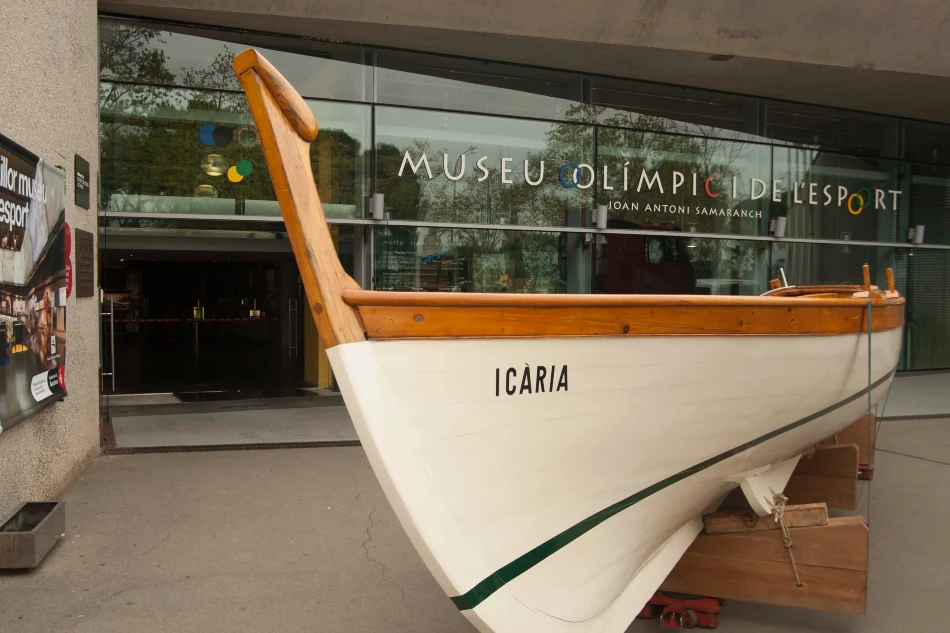
If you love sports, you must visit the Joan Antoni Samaranch Olympic and Sports Museum on Montjuïc Hill.
The museum offers a global perspective of sport in numerous disciplines, and visitors can perform virtual experiments with their idols.
The Joan Antoni Samaranch Collection contains pieces related to sport, art, and culture donated by the former IOC president.
Stop: Parc Montjuïc
Miramar Gardens
The Miramar Gardens are over a century old and 60 meters (197 feet) above sea level.
They offer majestic 270º views of Barcelona and contain hundred-year-old trees.
The gardens are landscaped into regular terraces, held in place by stone walls and wrought iron railings, with trees and various flower beds.
The central part of the garden is a stone fountain surrounded by three female sculptures – Fertility, Serenity, and Pomona.
Stop: Mirador Stop
Mirador de l’Alcalde
Mirador de l’Alcalde is a lookout point that takes advantage of the mountain’s steep incline to offer some of the finest views of Barcelona and the Mediterranean coast.
The park consists of a series of terraces distributed into various levels connected by stairways.
The park’s center is home to an ornamental fountain.
Stop: Mirador Stop
Mossèn Costa i Llobera Gardens
The Mossèn Costa i Llobera Gardens are on the south-east slope of Montjuïc Hill, and home to plants are from sub-desert, desert, and tropical zones.
The garden covers six hectares and has more than 800 species, making it one of the most crucial cactus gardens in Europe.
In 1987, The New York Times included the Mossèn Costa i Llobera Gardens on its list of the world’s top ten beautiful gardens.
Stop: Mirador Stop
How to get to Montjuic Cable Car
You can board and get down at any of the cable car stops.
And to reach them, you have a variety of transport options.
Take Line 2 or Line 3 of the Subway Service and get down at Paral·lel station.
You must take the funicular from the subway station to Parc de Montjuïc, the first cable car station.
The Funicular de Montjuïc is a mountain train that takes you on a quick trip from Paral.lel metro station to the cable car’s base station.
You can also board buses 55 or 150 and get off at the Miramar—Estació del Funicular bus stop.
FAQs about Montjuic Cable Car
Here are some questions visitors usually ask about this experience in Barcelona.
Where can I book tickets for the Montjuic cable car?
Visitors can purchase return tickets or one-way tickets. Return tickets can be booked online, while one-way tickets are available only at the ticket counters at the stations.
What does a return ticket allow?
Montjuic cable car’s return ticket allows you to board from any station and get off at any other two stations, explore, and then get back in to return. You can start and end your journey at whichever cable car station you prefer.
What is the validity of the return ticket?
Your ticket for a ride on the Montjuic cable car is valid for 90 days from the date of purchase. However, once you use it, it is only valid for that day—you must use it on the same day.
What is the departure point of the Montjuic cable car?
The cable car doesn’t have a specific departure point. You can use these tickets to board the cable car from any of the three stations.
Is Montjuic cable car wheelchair accessible for people with disabilities?
Yes, Telefèric de Montjuïc is wheelchair accessible with all the needful facilities in place for people with reduced mobility. Visitors needing extra assistance owing to their level of disability can contact a member of the staff at the station.
Can I take my pet into the cable car?
No animals are allowed on Telefèric de Montjuïc, with the exception of assistance dogs.
Can I cancel my Montjuic cable car ticket?
Yes, you can cancel or reschedule your visit until 11.59 pm the day before.
